My Blog - Jeff Clarke
Updates and photos from around the world on my travels both through pleasure and work
South Africa Part 3: Kruger National Park
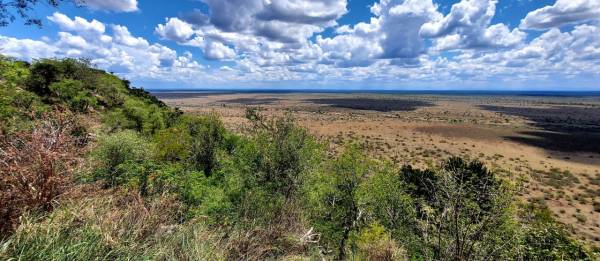
Click on the images to view them at full size.
Just uttering the words Kruger National Park can set the pulse racing and the synapses jangling. As the wheels of the 30-passenger jet kissed the tarmac at Skukuza, the excitement was palpable. We descended the steps at this tiny air strip, in the heart of the park, and were struck by a wall of heat and the ever-present caroo-ing of Mourning and African Turtle Doves. Hire car loaded, we exited the security gate. The speed limit is 50kph on tarmacked roads, 40kph on gravel. If you want to spot wildlife 25kph, or less, works better. We had an internal bet as to what big game we would spot first. Not a kilometre from the airport gate we found ourselves gawping at something akin to four ginormous distressed leather handbags, flapping their wardrobe door ears to keep cool in the shade of the thorn bushes, under which they sheltered from the sweltering sun. Our self-drive safari was off to a flyer with the biggest land mammal on the planet, the bull African Elephant. It took over an hour to drive the 7km to the Skukuza camp gate, our base for the first two nights of our 5-night tour.
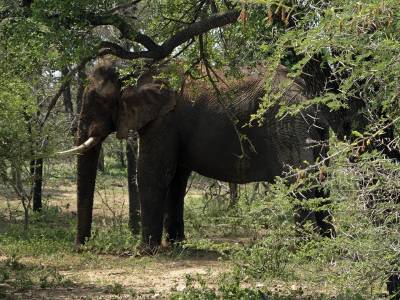

Bull African Elephant siesta in the shade Kruger NP © Jeff Clarke
Camp gates close just before sunset, woe betide you if you don’t get back in time. After check-in and unloading the car, we had just a couple of hours to explore nearby. We followed the H1-1 and hardly a kilometre from the camp we saw a small cluster of cars. As we approached, the object of fascination could be clearly seen draped across a shaded trunk, lithe and muscular with a ring-spotted coat, a snoozing male Leopard dreamed of Impala. We stayed for about 45mins, but he never budged we decided to search as far as the Mathekenyane viewpoint. Impala were abundant and we also enjoyed more elephants and several groups of Greater Kudu, the males of the latter look especially majestic with their corkscrewing horns.
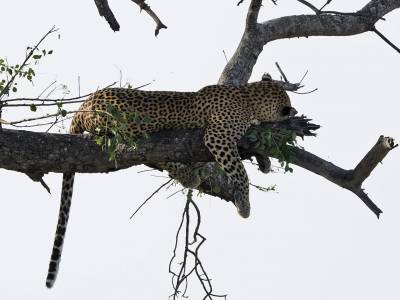
African Leopard snoozing near Skukuza camp © Jeff Clarke

Greater Kudu male near Skukuza camp © Jeff Clarke
Unlike 90% of people who safari in Kruger we were also interested in the birdlife and reptiles. It soon became obvious that we were a source of annoyance, people seemed genuinely perplexed when they stopped to enquire what we were looking at and we’d say something like “Woodland Kingfisher”, or “Diderick Cuckoo”. They’d invariably drive away muttering. Folk get obsessed with seeing the ‘Big Five’. They were missing out. Kruger is full of fantastic birds and other fabulous creatures. We returned to camp a few minutes before the gates closed for the night. We were already buzzing.
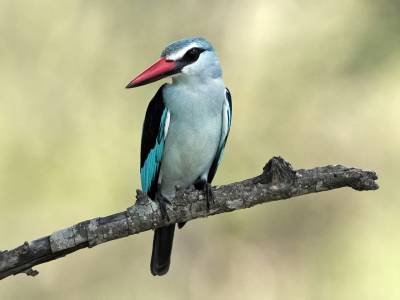

Woodland Kingfisher (left) & Diederick Cuckoo (right) near Skukuza camp © Jeff Clarke
Next morning the gates opened at 4.30am, before sunrise, and we exited moments later. Almost immediately we encountered our first Spotted Hyena, as it casually strode down the road in front of us for a couple of hundred metres, emitting its characteristic ‘whoop’ call every twenty seconds or so, before sauntering off into the bush. No sooner had one encounter ended before the next delight would appear. As the daylight gradually took hold photography became a realistic option and a Common Duiker posed close to the road, as too did our first Crested Francolin and Levaillant's Cuckoo.
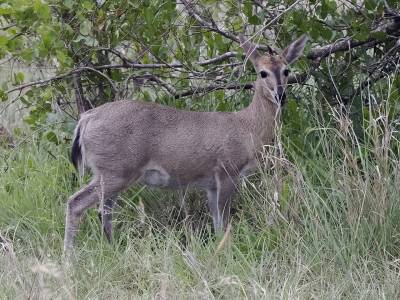
Common Duiker near Skukuza camp © Jeff Clarke
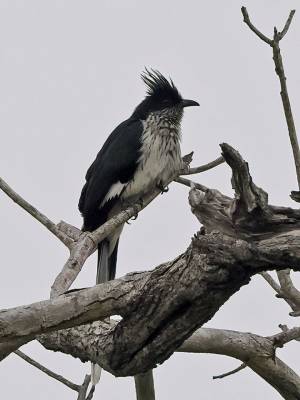
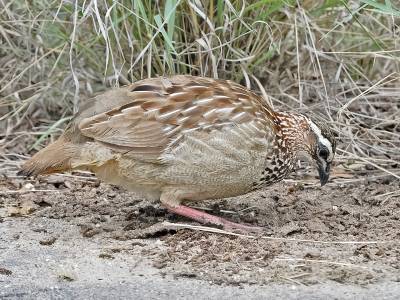
Levaillant's Cuckoo (left) Crested Francolin (right) near Skukuza camp © Jeff Clarke
Everywhere along the roads huge quantities of fresh animal dung had been deposited and some species were exploiting this potential food resource. We stopped to photograph a Red-billed Hornbill as it enthusiastically sifted its way through a mountain of elephant poo.
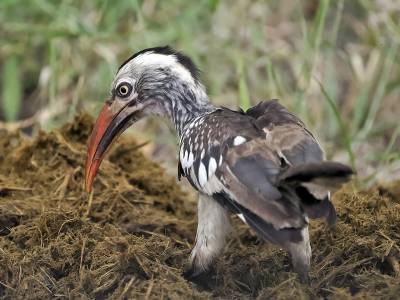
Red-billed Hornbill sifting elephant dung near Skukuza camp © Jeff Clarke
Kruger is home to several species of Mongoose and the smallest of the lot, the diminutive Dwarf Mongoose, was a daily delight. Usually encountered in groups, they could be very confiding, and their antics always made us smile.
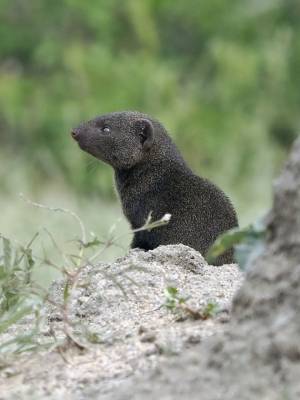
Dwarf Mongoose in a termite mound near Skukuza camp © Jeff Clarke
Given how easy it was to spot the mongooses, it was a source of wonder how easy it was to miss a 6m tall giraffe or 6,000kg elephant as you travelled along at a pedestrian 25kph. We worked out what our average speed was on our various journeys, and we averaged 9kph, partly because we kept finding things, especially spectacular birds, like Magpie Shrike to look at.

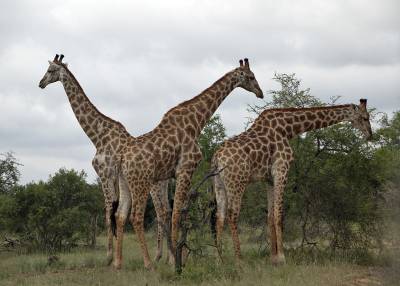
Giraffe browsing near Skukuza camp © Jeff Clarke
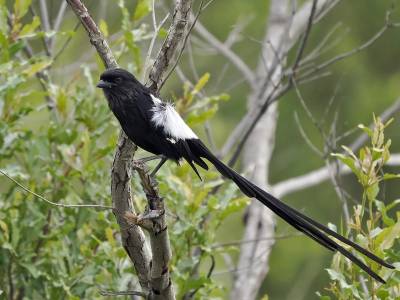
Magpie Shrike near Skukuza camp © Jeff Clarke
We’d been mooching along for a couple of hours when we approached a small cluster of cars. Lo and behold another Leopard was laid up in a tree approximately 75 metres away. She spent several minutes on her personal grooming, getting into positions any Yoga teacher would envy. Once she was happy that she couldn’t look any more gorgeous, she slinked down the tree, paused momentarily to gaze in our direction and then sauntered of into the bush, her spotted coat almost immediately rendering her totally invisible. A short, but very sweet, interlude.
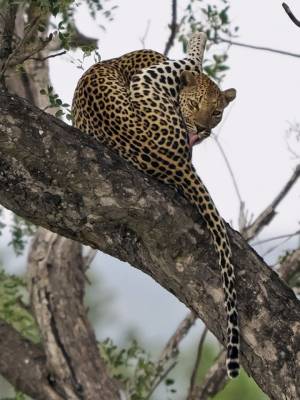
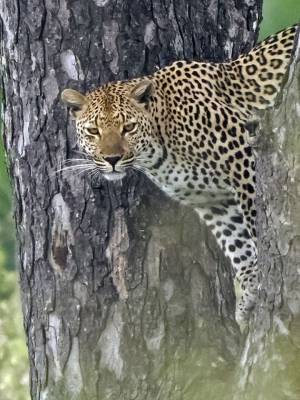
Female Leopard close to Skukuza camp © Jeff Clarke
You are not going to beat a Leopard for looks, but the day unfolded like a box of your favourite pick and mix selection. African Plains Zebra are strikingly marked animals, they are so alike and yet so-un-alike to the discerning eye. Each individual has its own utterly unique pattern of stripes. There is a lot of body language going on with zebras. It was fascinating and we spent lengthy periods just enjoying their, often subtle, interactions.
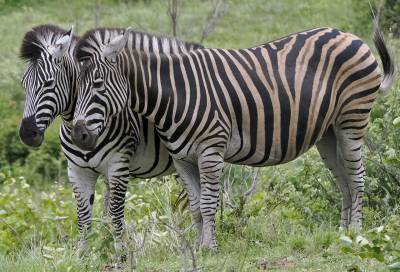
Plains Zebra near Skukuza camp © Jeff Clarke
By mid-morning we arrived at Panic Lake. A chance to leave the confines of the car and gain access to the hide. The activity was bustling. Notably from three species of weaver birds busily constructing nests and collecting nesting materials. Lesser Masked, Village and Thick-billed Weaver were all present.

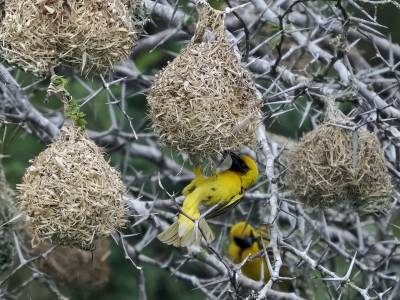
Lesser Masked Weaver (left) Village Weavers (right) Lake Panic © Jeff Clarke

Thick-billed Weaver weaving Lake Panic © Jeff Clarke
There were many different species viewable from the excellent hide. One that was just close enough for a reasonable photograph was Water Thick-knee, also known as Water Dikkop. What was intriguing about this bird is that it had an old 'leg-break' injury. It had healed a bit wonky but the bird was happy to stand on that leg.
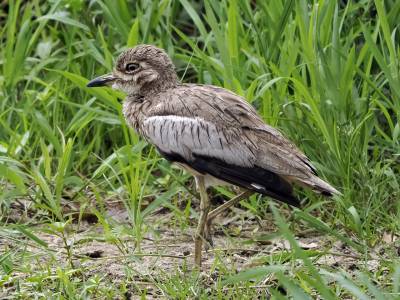
Water Thick-knee with old leg injury - Lake Panic © Jeff Clarke
After a very pleasant hour in the hide we decided to return to Skukuza camp for some much-needed refreshment and a chance to stretch our legs, but we didn’t get far before another memorable moment was upon us. An immature Bateleur Eagle was perched in a roadside tree ripping apart the remains of a small antelope. Most likely this was scavenged from a big cat kill.
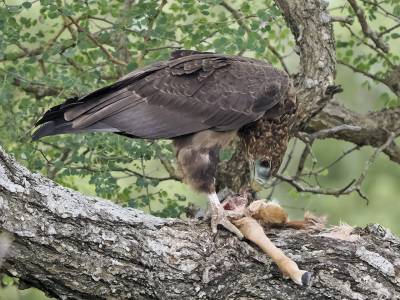
Bateleur Eagle consuming part of a small antelope near Skukuza camp © Jeff Clarke
Most of the wildlife in the camps, and there’s a lot of it, are very habituated to human presence and it’s possible to get close to most things without causing disturbance. Perhaps they relax because of the human presence and the fact that there is a big electrified fence keeping out the apex predators. Reptiles are very noticeable in the camps with the Black-necked Tree Agama being among the most colourful. The camps, in general, are haven for birds, that included the likes of Black-collared Barbet


Black-necked Tree Agama (left) & Black-collared Barbet (right) Skukuza camp © Jeff Clarke
Feeling a bit rested we set off for our afternoon drive to Nkuhlu picnic site. A few minutes from camp we chanced upon a party of White-fronted Bee-eaters. Many of the birds were busy ‘panting’ to try and lose heat. The scorching sun meant that almost every mammal had taken cover in whatever shade they could find. A herd of Impala were clustered underneath roadside bushes and their hides were decorated with Red-billed Oxpeckers. Often regarded as the very definition of symbiosis. Both parties benefit from the relationship. Though new research suggests the relationship is somewhat more complex than that.
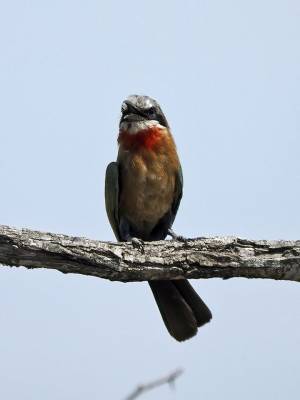
White-throated Bee-eater near Skukuza camp © Jeff Clarke

Red-billed Oxpeckers on Impala close to Skukuza camp © Jeff Clarke
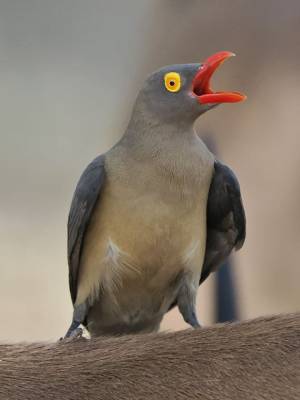

Red-billed Oxpeckers near Skukuza camp © Jeff Clarke
Nkuhlu picnic site itself was full of wildlife and it was great to be able to wander freely (within limits) and stretch the legs. A fruiting tree was a hosting a large troop of Vervet Monkeys. We spent a little while enjoying their antics and watching thier social interactions. These are highly intelligent animals.
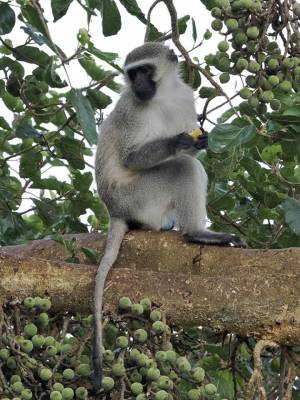

Vervet Monkeys Nkuhlu picnic site © Jeff Clarke
A slow return to Skukuza brought us a few more roadside rewards, the pick of which was probably a Lizard Buzzard perched in a tree very close to the road and little further on we finally got a really decent view of an adult Bateleur Eagle. By far the most abundant mammal on view was the Impala antelope, including many splendid looking bucks. The best of the reptiles was another Leopard Tortoise. Though they should probably be called 'Cheetah Tortoise', as they are so speedy.


Bateleur Eagle adult (left) & Lizard Buzzard (right) © Jeff Clarke
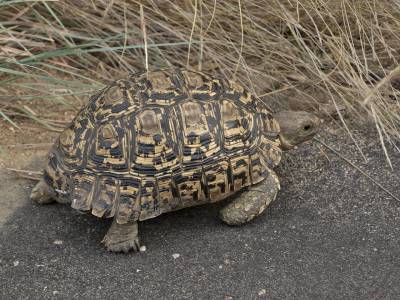
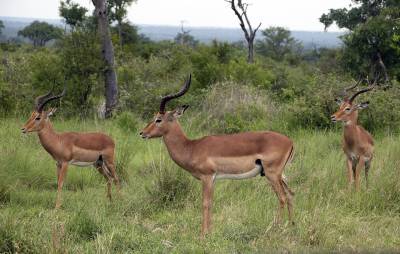
Leopard Tortoise (left) & Impala bucks (right) © Jeff Clarke
Our second full day in Kruger saw us departing Skukuza as the gates opened. We were headed north, to Satara camp. As we crossed the Sabie River, four Spotted Hyenas were crossing the riverbed, a African Pied Wagtail was on the bridge and a juvenile Green Heron flushed from the far bank and perched briefly in full view. We travelled slowly searching and scanning every gap in the thornveld habitat. Impala were abundant as usual, and we hadn’t travelled more than a couple of kilometres before encountering our first Blue Wildebeest, a powerful bull, in prime health. A little further down the road, a lovely Nyala was browsing in a dip. This species tends to stick to cover a bit more than some of the other antelope.
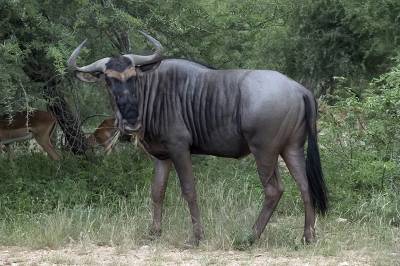
Blue Wildebeast near Skukuza © Jeff Clarke
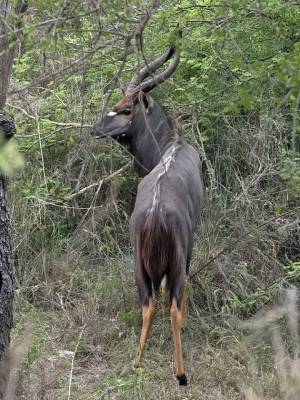
Nyala near Skukuza camp © Jeff Clarke
Kruger N.P. seems to hold something to watch around every bend in the road. This made for pedestrian progress towards Satara. Having seen all of our Hyena's either distantly, or in twilight conditions, it was good to finally get one in close view in full daylight right next to the road.

Spotted Hyena near Skukuza © Jeff Clarke
As we slowly progressed, the numbers of Rollers seemed to increase significantly and Lilac-breasted Roller became the dominant species. We made an intended stop at Tshokwane picnic site.
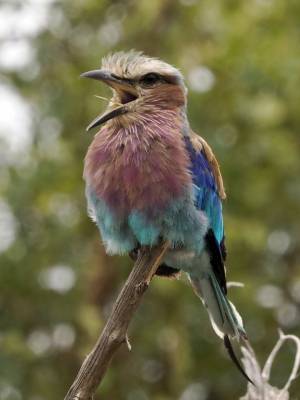
Lilac-breasted Roller near Tshokwane picnic site © Jeff Clarke
In habitats surrounding the picnic site and in the grounds themselves there was a tremendous variety of birds to be enjoyed. In the more open areas were Sabota Larks and Swainson's Francolin. The scrubby patches held delights such as White-browed Scrub-Robin, Green-winged Pytilia and Burchell's Starling. This is where we witnessed a Southern Grey-headed Sparrow and a Long-billed Crombec have an argumentative face-off. The picnic site itself held ferocious looking Crested Barbet, stunningly lovely Collared Sunbirds and the irridescent dazzler in-chief Greater Blue-eared Starling.
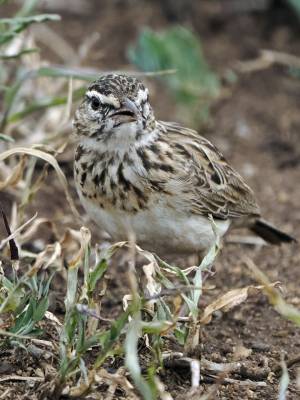

 Sabota Lark (left), Swainson's Francolin (middle), Burchell's Starling (right) © Jeff Clarke
Sabota Lark (left), Swainson's Francolin (middle), Burchell's Starling (right) © Jeff Clarke
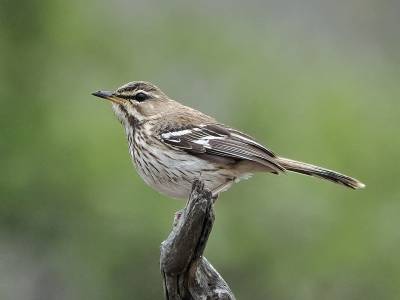
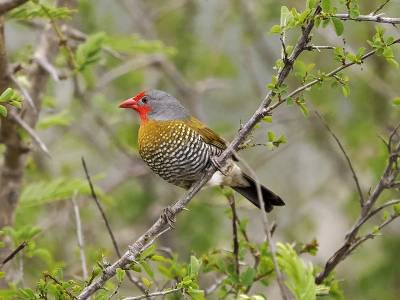
White-browed Scrub-Robin (left), Green-winged Pytilia (right) © Jeff Clarke

Southern Grey-headed Sparrow and Long-billed Crombec in conflict © Jeff Clarke
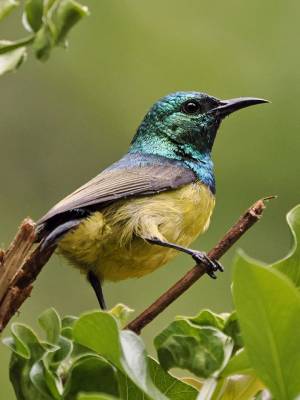

Collared Sunbirds male left, female right © Jeff Clarke
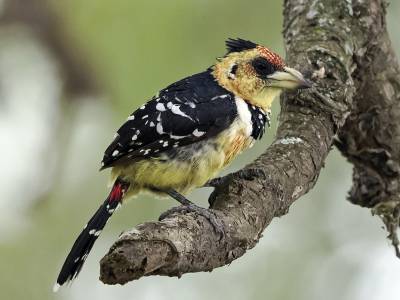
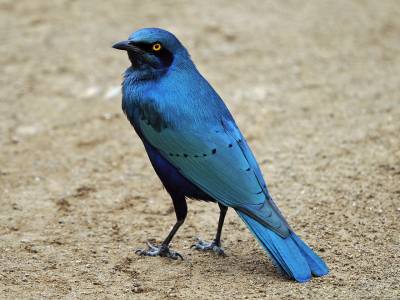
Crested Barbet (left) Greater Blue-eared Starling (right) Tshokwane picnic site © Jeff Clarke
As we continued further north, we immediately bumped into our first Southern Ground Hornbills. These very large birds are a real curiosity, they sedately patrol along searching out lizards as a favoured prey item. They have huge bills with lots of vermillion facial and throat pouch skin, which may seem like their most distinctive feature, but they also have curiously tiny feet. The Barbie of the hornbill world.
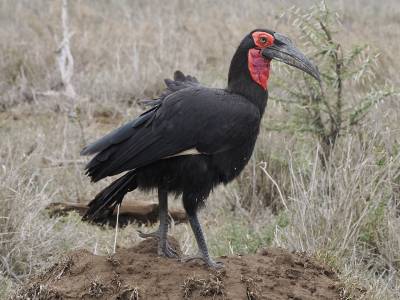
Southern Ground Hornbill near Tshokwane picnic site © Jeff Clarke
The road here often clips against the meandering Nwaswitsontso river and so it was no surprise that Waterbuck were a regular feature as we trundled along. These shaggy coated antelope are possessed of an unusually marked derriere, with a large arcing crescent on either buttock creating a target-like appearance. Another stop just minutes later provided us with a lovely view of Steenbok as it pranced by with a featherlight grace. We also came upon a few Chacma Baboon troops, probably because the riparian ribbon of large trees along the banks of the river provided them with safe nocturnal refuges. One large troop played for some twenty minutes on the road in front of us, it wasn’t a burden to watch their antics. They paid us no heed whatsoever.
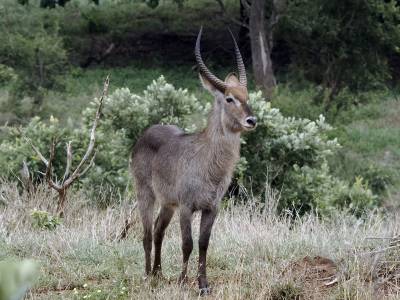

Waterbuck showing off its distinctive bottom ring © Jeff Clarke
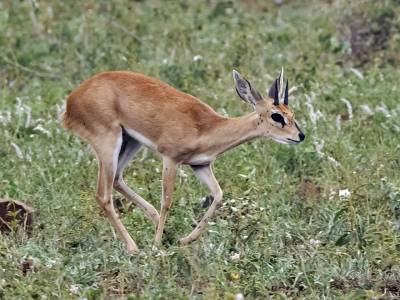
Steenbok near Satara © Jeff Clarke
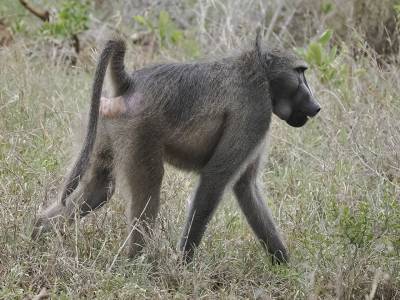
Chacma Baboon near Satara © Jeff Clarke
A short distance beyond the baboons we found our one and only Yellow-throated Longclaw, quickly followed by a mighty adult Martial Eagle perched in a roadside tree. The shrubs and bushes were exceedingly productive for shrikes and we had a creditable six species including both Black- and Brown-crowned Tchagra, though Red-backed Shrike was by far the most abundant. We also got one of our better photographic opportunities with Burchell's Coucal. Every now and again we would get decent aspect of the river and one of the viewpoints yielded us a Woolly-necked Stork that promptly set about massacring a frog.
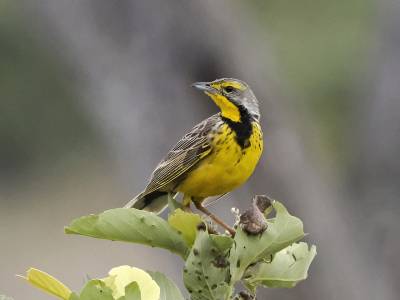

Yellow-throated Longclaw near Satara © Jeff Clarke

Martial Eagle adult near Satara © Jeff Clarke


Brown-crowned Tchagra (left) Burchell's Coucal (right) near Satara © Jeff Clarke
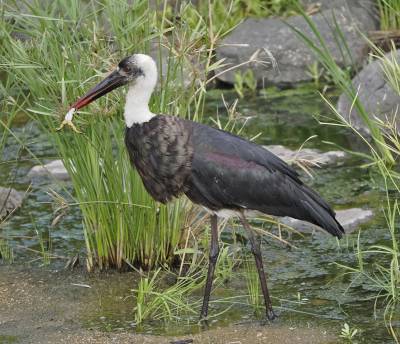
Woolly-necked Stork with frog prey near Satara © Jeff Clarke
The bushveld on route to Satara is full of birds, being restricted to your vehicle obviously limits your views, and as a birder you will always be fighting the urge to get out and have a mooch around, but on the plus side the car is a very effective hide, and when the opportunities do arise, you can get surprisingly intimate views and images of many of the smaller birds found in the National Park. A good example is the tricky cisticola family, they are not always easy to get to a species identification, so getting a decent image is big help. In this case it was a Rattling Cisticola that perched up in a roadside bush, to provide a confirming portait.

Rattling Cisticola near Satara © Jeff Clarke
A few kilometres from Satara we stopped to enjoy the antics of a troop of Dwarf Mongooses. An Afrikaans family stopped to enquire what we were watching and we failed to get them to understand. We later met them at the camp and showed them a picture of the mongooses. They were underwhelmed.

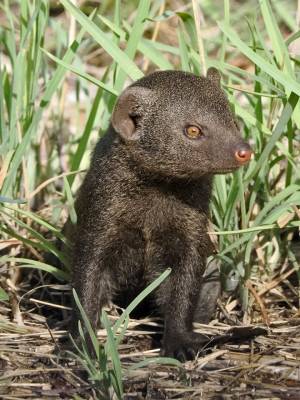
Dwarf Mongooses on roadside near Satara camp © Jeff Clarke
Satara was a lovely campsite, but the local troop of Vervet monkeys were on the naughty step as they were expert food thieves. One of the remarkable aspects of the camp were the huge numbers of Little Swifts swirling around overhead. Their trilling calls echoing around the camp with a doppler-like quality.
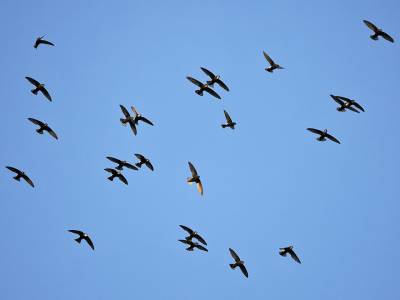
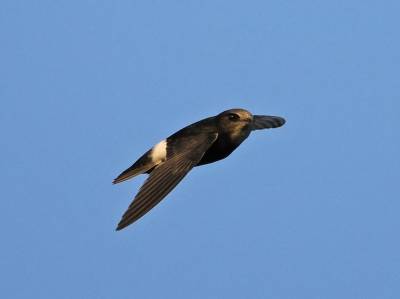
Little Swifts at Satara camp © Jeff Clarke
Up early again and heading west along the H7 toward Nsemani dam. We quickly found a Black-bellied Bustard on his display mound, and a Red-crested Korhaan in full display on another termite mound. A short distance further on one of the few White-headed Vultures we saw perched conveniently on a roadside tree.
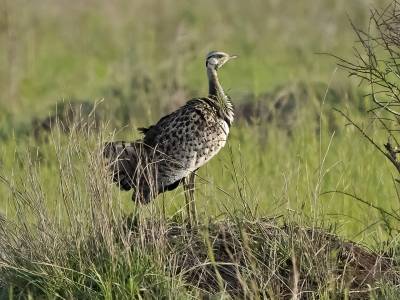
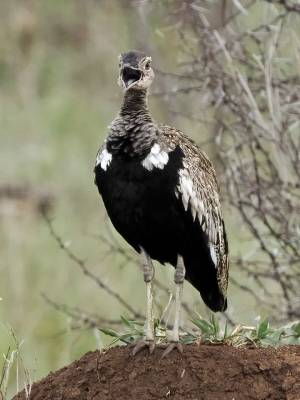
Black-bellied Bustard (left) & Red-crested Korhaan (right) near Satara camp © Jeff Clarke
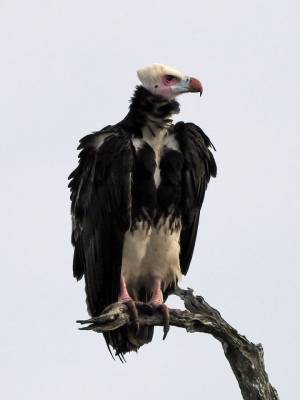
White-headed Vulture near Satara camp © Jeff Clarke
The area surrounding the dam was brimming with wildlife. Good numbers of the curious Comb Duck, with its extravagant knob-like protuberance on the male’s upper mandible. There were also plenty of White-faced Duck around the margins of the open water.
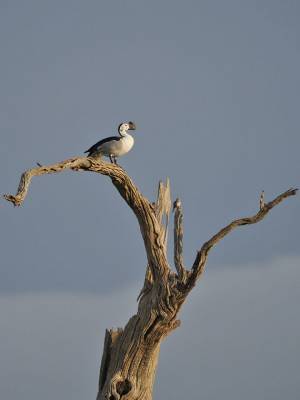

Comb Duck perched on a tree (left) & White-faced Duck (right) at Nsemani Dam © Jeff Clarke
A procession of animals came to drink and bathe, including elephants, Plains Zebra, Impala and Greater Kudu. On the banks two young Hippopotamuses were cavorting in play-fighting fashion, practicing for more serious combat once they reach adulthood..
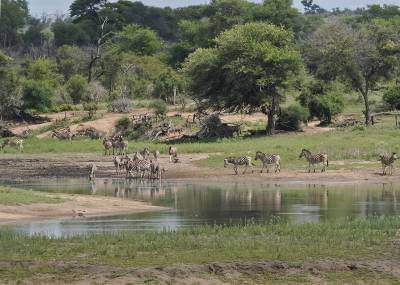
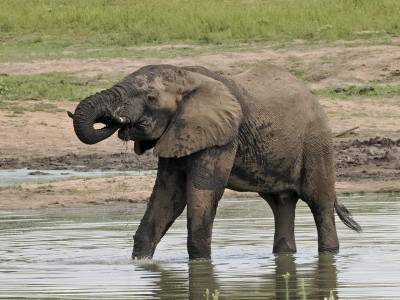
Plains Zebra herd and African Elephant drinking at Nsemani Dam © Jeff Clarke
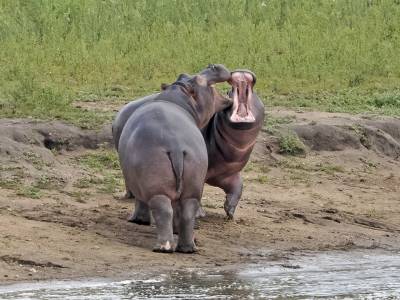
Young hippos play-fighting Nsemani Dam © Jeff Clarke
We contemplated heading towards the Orpen gate in the hope of catching up with a Cheetah, but decided against it, but by chance we came across a cluster of cars watching what would be our third Leopard of the trip. This one had stashed a wildebeest calf in a roadside tree, before crossing the road to lie up in the shade. We then did a U-turn and headed for the Sweni dam, via the game-rich S100. As we headed back we got a superb roadside view of a European Roller, a truly stunning looking creature. On route we made a brief stop back at Satara camp to grab some provisions and photograph the Epauletted Fruit Bats hanging in the trees close to the reception building.

European Roller near Satara Camp © Jeff Clarke
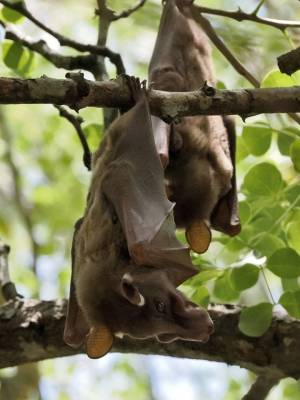
Epauletted Fruit-bat sp. at Satara camp © Jeff Clarke
The S100 proved its worth with large herds, many with newborn young, of Impala, Plains Zebra and Blue Wildebeest and Warthog alongside lots of Elephants, Greater Kudu and Giraffe. The latter included a pair of teenage males having a handbags-at-dawn type shoving match.
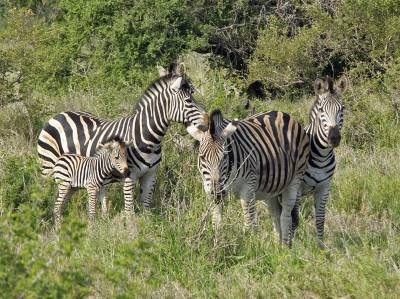
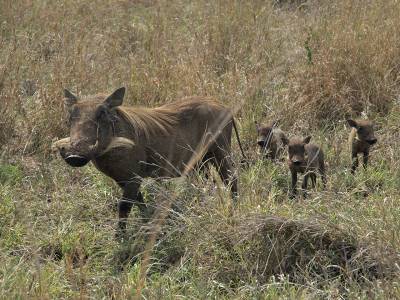
Plains Zebra with foal (left) & Warthog with hoglets (right) © Jeff Clarke
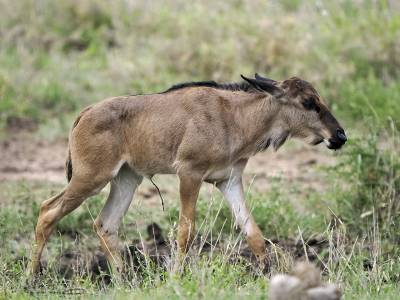

Blue Wildebeast calf (left) Impala lamb (right) © Jeff Clarke
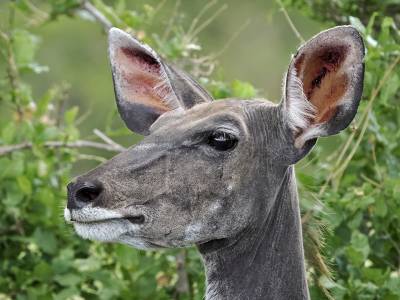
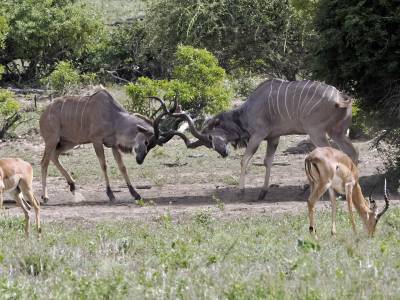
Kudu female (left) young Kudu bulls sparring (right) near Satara © Jeff Clarke
Along this road we got an excellent view of a male Long-tailed Paradise Whydah and Red-breasted Swallow. Sweni-dam itself was something of a disappointment with relatively few birds in attendance, though we did have an obliging Open-billed Stork which turned out to be the only one we saw the whole trip.
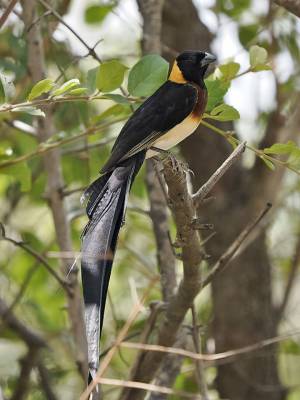
Long-tailed Paradise-Whydah near Satara © Jeff Clarke
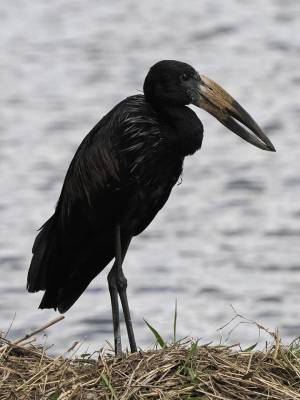
Open-billed Stork Sweni Dam © Jeff Clarke
We decided to return to Satara via the H6. The savannah is quite open in parts of this road and we stopped a couple of times to scan in the hope of finding a big cat. A distant dot under an overhanging dead branch, looked like the head of a cat. Out came the scope. Bingo! There lay a Cheetah, sheltering from the blazing sun. It was too far for anything other than a record shot. We sat and watched it for ages in the hope it would get up. But other than a bit of stretching and looking around it was intent on resting. We did manage to get a couple of passing motorists on to it. We posted the sighting when we got back to Satara, where we chanced on a Black-backed Jackal at the entrance. Following this we headed back to Nsemani dam again to watch a herd of elephants coming to drink and photographed both Wahlberg's Eagle and African Fish Eagle in gorgeous evening light.
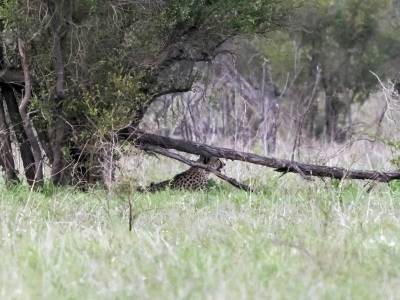

Very distant Cheetah close to Satara (left) Black-backed Jackal (right) © Jeff Clarke
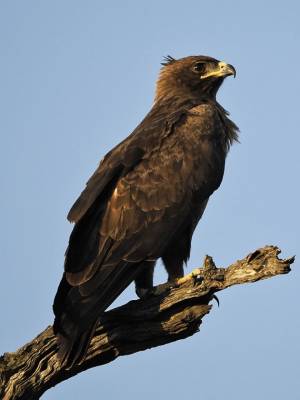
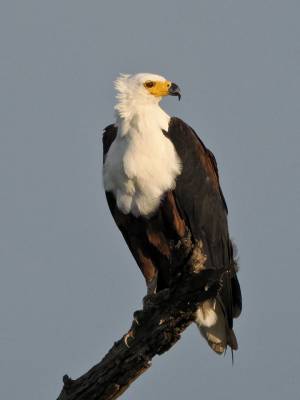
Wahlberg's Eagle (left) African Fish Eagle (right) Nsemani Dam © Jeff Clarke
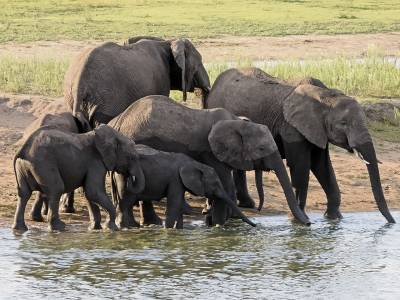
African Elephant family drinking at Nsemani Dam © Jeff Clarke
We returned to Satara to join a night-drive. We didn’t take the cameras, possibly a mistake as we had a superb sighting of a Marsh Owl and an African Wild Cat, but still no lion. We were beginning to think we may miss out on this iconic apex predator
Next day we departed Satara before sunrise, heading for Lower Sabie camp. We’d only travelled a couple of hundred metres when we noticed a couple of cars had stopped. Somebody had noticed a pride of lions moving in the distance. We scanned and after few moments we picked them up. They were coming our way. They moved steadily and easily, several females, a single young male and three cubs. At least ten animals in total. At the perfect moment the sun rose above the horizon to illuminate the lead lioness as she padded with majestic grace to within fifty metres of our car. We were spellbound and just in awe of the top lioness, she looked exceptionally well fed and was all rippling muscle. She was quite literally ‘golden’. She is seared into the mind’s eye. Thankfully I captured some passable images, but they barely do her justice.

African Lioness caught in the first rays of the rising sun at Satara © Jeff Clarke
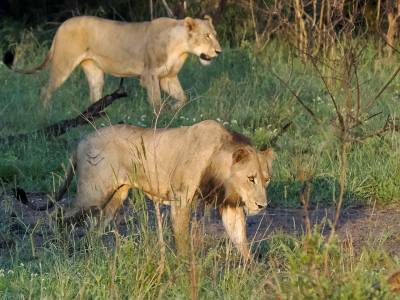
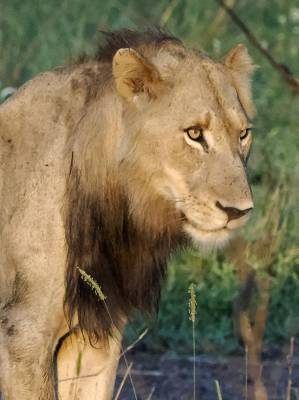
Adolescent African Lion just after sunrise at Satara © Jeff Clarke
After a few minutes the pride crossed the road and slowly meandered off into the distance. We resumed our journey only to stop a couple of minutes further down the road as a confiding male Black-bellied Bustard decided to display only 3 metres from our stationary vehicle. This bird’s performance verges on the comical with a call that has a loud ‘tchickk’ to begin then after a dramatic pause a loud pop, like a champagne cork going off, completes that segment of display.
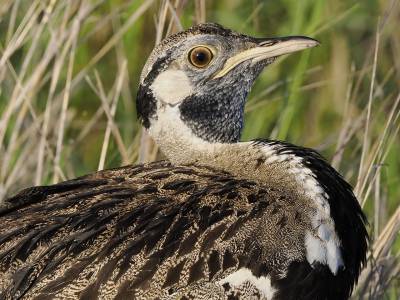
Black-bellied Bustard near Satara © Jeff Clarke
We would make a stop at Tshokwane on route, but first we once again diverted down the track to the southernmost Boabab tree in Africa. This proved to be a very fortuitous decision as it brought us some exceptional close-up views of a number of Kruger’s characteristic birds. I’ve always found Namaqua Doves frustrating birds to photograph but this time a male perched in stunning early morning light as it went through a lengthy preening routine.
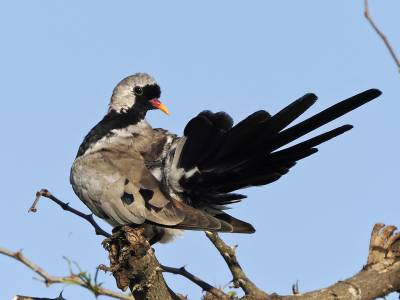
Nemaqua Dove male near Tshokwane © Jeff Clarke
One of the most abundant birds in Kruger during December is the Red Backed Shrike. Despite its scarcity in the UK, I’ve enjoyed many wonderful encounters with this species over the years but I’ve never seen anything like the numbers present in Kruger NP. They were incredibly abundant and this morning one particular male perched characteristically atop a small thorn bush, perfectly lit, with the car a just a few feet away allowing me to take some wonderful images.
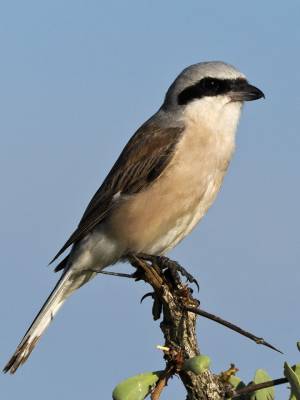
Red-backed Shrike male near Tshokwane © Jeff Clarke
A little further down the track a Jacobin Cuckoo provided another photographic opportunity. The bird’s pied plumage is the source of its name. Jacobin was the name given by the French to the Dominican Order of monks, because of their black and white garments. They parasitise a wide range of birds, most are in the babbler or bulbul families.

Jacobin Cuckoo near Tshokwane picnic site © Jeff Clarke
When we got to the Baobab we noticed it was in full flower. The flowers look extraordinarily like an animal’s face. It reminded me of ‘Rafiki’ the Mandrill baboon character from the Disney film Lion King. The resemblance is uncanny.

Baobab Tree flower or Rafiki? You decide. © Jeff Clarke
As we resumed our very sedate journey towards Tshokwane we saw a movement under a bush a short distance ahead. We pulled up and waited. After few minutes the slinky form of a Slender Mongoose emerged from the base of the bush and it came out onto the road. It kept its body almost flat to the surface, as if trying to soak up the warmth from the tarmac.
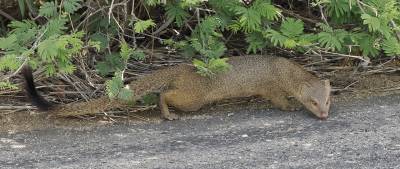
Slender Mongoose near Tshokwane picnic site © Jeff Clarke
As you approach Tshokwane picnic site the road runs alongside the River Nwaswitsontso. We pulled in to scan the riverbank at various points and one stop was perfectly timed to spot a big male Leopard settling down in the grass along the river edge. He stayed there for a few minutes before slowly heading back up to the cover of the riparian woodland at the top of the bank. What a privilege.

African Leopard male near Tshokwane picnic site © Jeff Clarke
We spent the rest of the day pootling towards Lower Sabie camp via Orpen Dam. It’s a lovely overview prospect here and is a site well known for White Rhino. Thankfully we saw a mother and calf combination, but they were so distant even the James Webb telescope would have struggled to produce a viable image. There were other animals to enjoy somewhat closer to hand, including a beautifully marked Blue-tailed Skink.
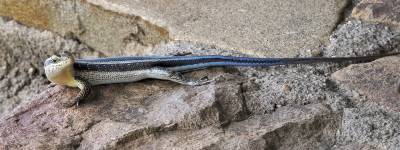
Blue-tailed Skink Orpen Dam © Jeff Clarke
The day was now fiercely hot and everything was heading for shade. We continued our travels and eventually made Lower Sabie in the late afternoon.
We explored the camp a little, getting views of various sunbirds, including Collared and White-bellied Sunbird, a beautiful Blue Waxbill and a small African warbler called Burnt-necked Eromela.
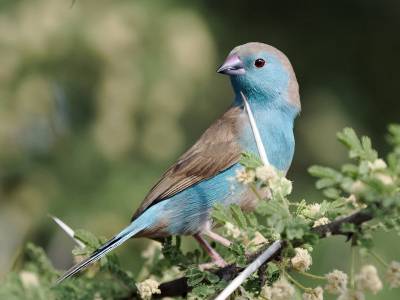
Blue Waxbill Lower Sabie camp site © Jeff Clarke
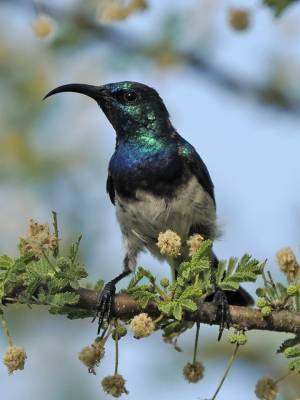
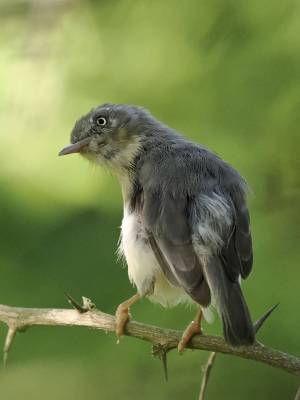
White-bellied Sunbird (left) & Burnt-necked Eremola (left) © Jeff Clarke
After a short break we headed out to Sunset Dam and enjoyed a fabulous couple of hours watching the shenanigans of the hippos and getting extremely intimate views of a wonderful variety of wetland associated birds. The hippos were either lying motionless or occasionally erupting into quarrelsome violence. There was much ‘yawning’ and the less pleasant ‘dung spraying’ to indulge in as the occasional sideline activity. As sunset approached a number of groups left the water to head off and forage in the bush.
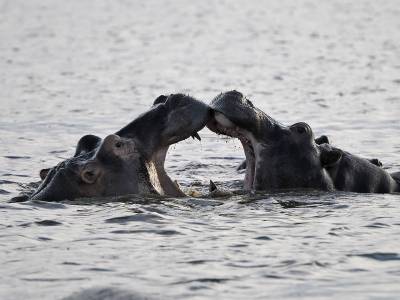

Hippo action at Sunset Dam © Jeff Clarke
There were plenty of Nile Crocodiles visible along the margins of the lake, one or two of the smaller ones were attempting to ambush the various wading birds and wildfowl along the shoreline, the birds were wise to their presence.
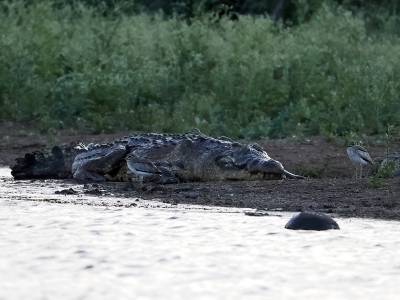
A large Nile Crocodile in repose flanked by Water Thick-Knees © Jeff Clarke
Some of the ‘flooded’ shoreline trees are home to large colonies of weavers. Village and Lesser Masked Weavers are by far the two most abundant species. Every now and then a commotion would set-up in the colony as a Diderick Cuckoo made a raiding foray into the collection of dangling nests.
We’d strategically positioned the car to get the best of the light and this allowed extremely close photographs of a big selection of wetland birds, including northern migrant waders such as Wood and Common Sandpiper. There were also local residents in the form of Three-banded Plover and African Jacanas, the latter plodded by with their outsized, clown-like feet. All of these were having to give-ground to another very aggressive wader, the White-crowned Lapwing. This bird seemed to take exception to anything in its path.
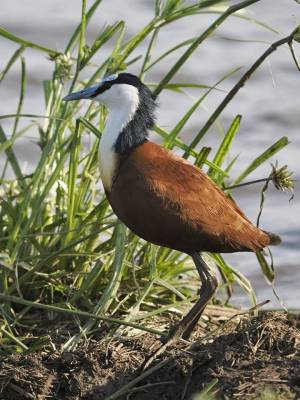
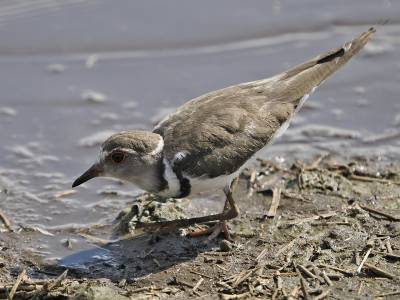
African Jacana (left) & Three-banded Plover (right) © Jeff Clarke
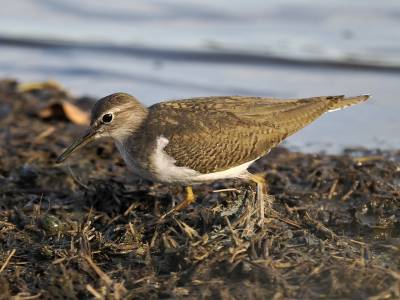
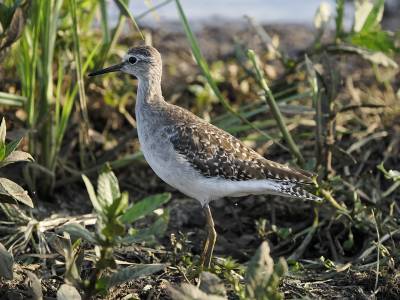
Common Sandpiper (left) & Wood Sandpiper (right) © Jeff Clarke
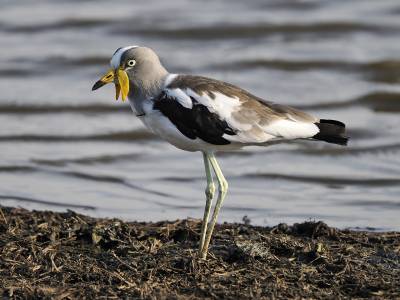
White-crowned Lapwing at Sunset Dam © Jeff Clarke
All too soon we were forced to head back to camp to avoid being locked outside the gates for the night.
Our final day in Kruger NP began with a slow drive back out past Sunset Dam as we wended our way towards Skukuza. There are few pull-ins alongside the Sabie River and this gave us plenty to savour, including the sumptuous Violet-backed Starlings and the slightly less gorgeous Wattled Starling. Probably the bird highlight of the morning was a pair of Double-banded Sandgrouse, that posed beautifully in the cool morning light.
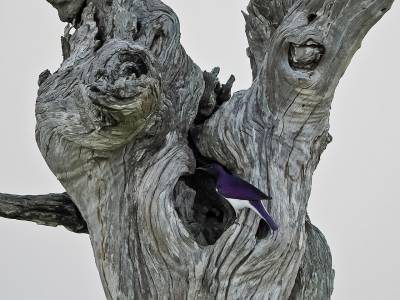
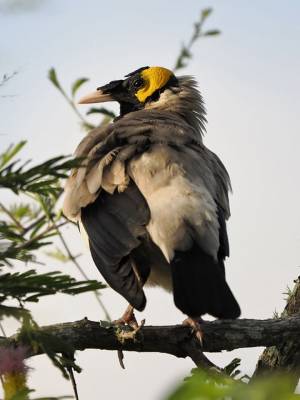
Violet-backed Starling at nest site (left) & Wattled Starling (right) © Jeff Clarke
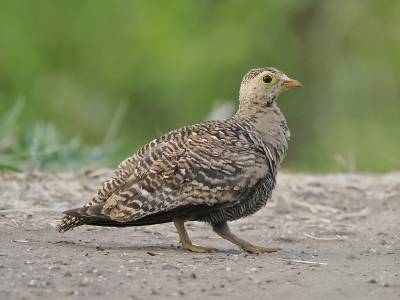
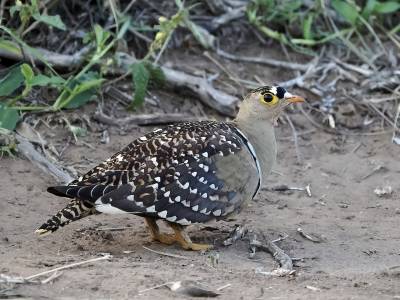
Double-banded Sandgrouse female (left) male (right) © Jeff Clarke
A little further down the road towards Skukuza we also had lovely views of an African Hoopoe feeding at the side of the road and at the Sabie River crossing, a pristine African Pied Wagtail. We called in to Skukuza camp for a short break and refreshments before heading to the airport. The riverine trees here attract a lot of wildlife and we were able to enjoy very close views of African Green Pigeon and a Pied Kingfisher that was subduing a fish, prior to consumption. Across the river a large kettle of vultures was thermaling upwards, the majority were White-backed Vultures, with a few Cape Vultures mixed in and just a couple of White headed Vultures amongst them.
.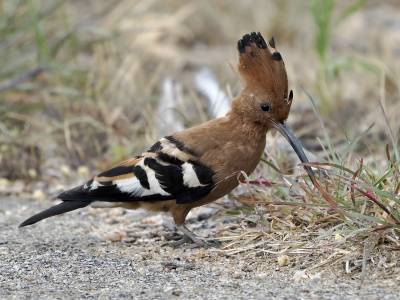

African Hoopoe (left) & African Pied Wagtail (right) © Jeff Clarke
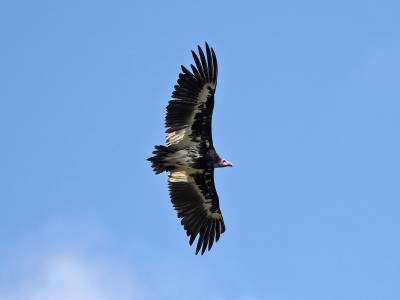
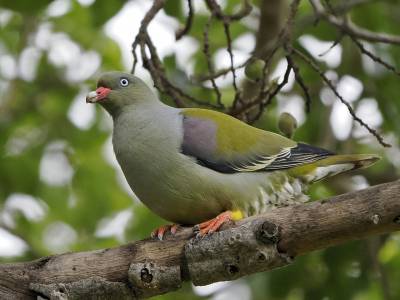
White-headed Vulture (left) African Green Pigeon (right) © Jeff Clarke
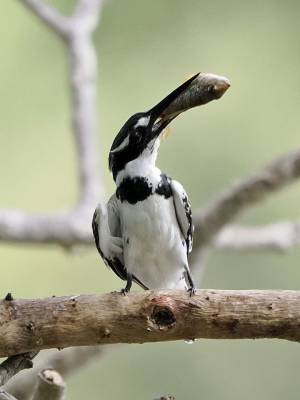
Pied Kingfisher subduing a fish © Jeff Clarke
Mammal-wise there was much to enjoy during the journey between Lower Sabie and Skukuza. We had our closest encounter with an African Buffalo as one sauntered across the road in front of us. Down a dirt side-track we almost bumped into a notoriously beligerent beast. Just a couple of metres from the dusty edge of the road the, huge, rotund form of an adult hippo stared at us with barey contained contempt.
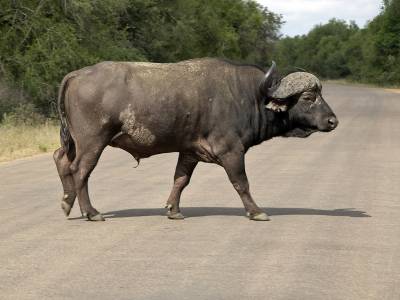
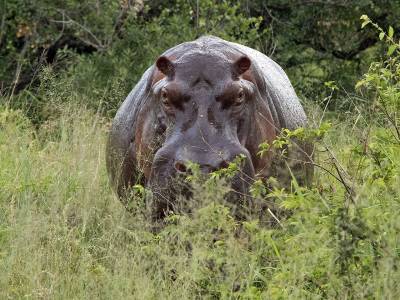
African Buffalo near Lower Sabie camp (left) © & grumpy looking Hippo (right) © Laura Dennis
This was just a prelude to something special, because we were about to have lifetime moment. As we slowly cruised along the road close to the Sabie River, we spotted a large herd of elephants just exiting the water. They looked like they would come up the hill and past us, so we chose a strategic spot to park and watch from. We had expected perhaps fifty would pass close to us. Over the next twenty minutes or so, over 200 elephants passed in front of us, so many matriarchal groups, and lots of very young baby elephants jostling between the legs of their mothers as they crossed the road. It was a truly emotional experience. We did take some photographs, but we mostly just watched and soaked in a little of the social lives of these exceptional animals.
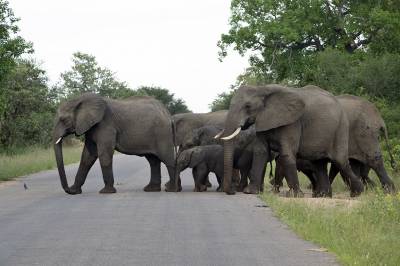
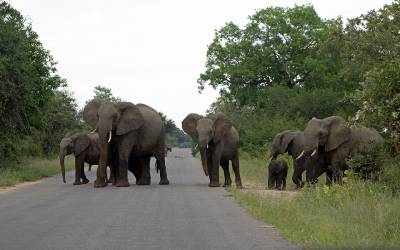
A river of African Elephants crossing the road, on route to Skukuza from Lower Sabie camp © Jeff Clarke
We saw plenty more wonderful animals before boarding our flight back to Cape Town, but nothing was going to beat that. What a finale to our short exploration of Kruger. All there is to do now is file the memories and plan our return. We cannot wait!



